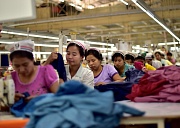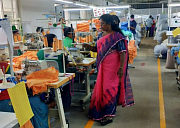Lutz Walter, secretary general of the European Technology Platform for the Future of Textiles, outlines why the claim that the fashion industry is to blame for 10% of global greenhouse gas emissions is wrong – and why this matters.
Four years after Ecotextile News debunked the myth that the textile industry was responsible for more greenhouse gas emissions than “aviation and maritime shipping combined” – a claim still parroted ad nauseum – it’s time for another critical appraisal of how much the fashion sector contributes to CO2 emissions.
The most frequent contributory figure found in policy briefs, regulatory proposals, NGO reports or consumer news outlets is that the sector is responsible for 10% of total global greenhouse gas (GHG) emissions.
Tracing this to its original source, most links or footnotes lead to a 2018 article by the United Nations Environment Programme (UNEP) entitled ‘Putting the brakes on fast fashion’. However, the English version of this webpage says: “The fashion industry produces between 2 to 8 per cent of global carbon emissions.”
The French, Spanish and Russian language versions of the exact same article say: “The fashion industry generates 2–8 % of wastewater and 10% of global carbon emissions.” Rather than something getting lost in translation, a whopping 2-8% of global GHG emissions was added to the fashion industry.
What is the true value?
Thankfully, the English text version links the source for the 2–8% claim to a 2018 report, produced by sustainability consultancy Quantis, entitled 'Measuring Fashion - Environmental Impact of the Global Apparel and Footwear Industries'.
In this study Quantis pegs the total climate impact, measured in million metric tons CO2e, of the apparel and footwear industry at 8.1% of total global GHG emissions, 6.7% for apparel and 1.4% for footwear.
The study has several significant data gaps and uncertainties which the authors acknowledge. Perhaps the biggest one is the amount of fibre production used for apparel which for the study was assumed as 84% of total textile fibre production, based on likely outdated or uncertain data from the FAO’s World Apparel Fiber Consumption Survey (2013).
Yet the relative share of total textile fibre production used for apparel is in steady decline and today is likely not much more than 50% and falling. The rest of textile fibres produced are processed into home and household textiles, technical textiles, nonwovens, and composites. This correction alone brings apparel’s share of GHG emissions from 6.7% down to 4.4%. It’s a huge difference.
Meanwhile, a study published by McKinsey and Global Fashion Agenda entitled “Fashion on Climate” pegged the fashion industry’s GHG emissions in 2018 at 2.1 million tons CO2e or 4% of the global total. This study, notoriously opaque about its assumptions and data sources, assigns 38% of total fashion industry emissions to the fibre production stage, for which no other comparable study comes anywhere close. For instance Quantis assigns only 15% to fibres and an 2023 UNEP study only 12%.
Another recent study entitled “Taking Stock of Progress Against the Roadmap to Net Zero”, published by the Apparel Impact Institute industry, estimated 897 million tonnes of CO2e in 2021, less than half of the McKinsey/GFA estimate, and representing only 1.8% of global GHG emissions. A slightly earlier but closely related study from the World Resources Institute estimated 1.025 gigatonnes of CO2e in 2019, roughly 2% of global emissions.
When searching for global GHG emissions by sector, a graph on OurWorldinData.org, based on input from Climate Watch, pegs the total emissions from energy use in global industry at 24.6%. Removing data from very energy-intensive industries leaves around 10.6% which totals “energy-related emissions from manufacturing in other industries including mining and quarrying, construction, textiles, wood products, and transport equipment (such as car manufacturing)”.
It wasn’t possible to locate the exact percentage for textiles within this number but would be highly surprised if it was more than 10-15% of this – textiles is called a ‘light industry’ for a reason!
So, let’s say textiles is around 1.5% of total GHG emissions. But then we need to add the GHG emissions related to the production of chemical processes such as ammonia, cleaning products, plastics, fertilisers, pesticides and indeed synthetic textiles. These together make 2.2% of the global total. So, let’s be aggressive and steal another 0.5% for textiles from there.
Then agriculture is responsible for 18.4% of global emissions. Cotton and other fibre crops represent around 1% of global agricultural land, but let’s be aggressive again, and say they represent 3% of agricultural emission so we can add another 0.5% to our total.
Adding these three figures together: 1.5% + 0.5% + 0.5% gives us a reasonable estimated 2.5% of global GHG emissions for the textile industry (including all non-apparel uses).
Another approach would be to use the online personal footprint calculator from ADEME, the French Agency for the Environmental Transition. Here, the average French consumer is listed as having a 450 kg CO2e on a total consumption footprint of 9,230 kg CO2e or 4.8% of the total.
The French consumer has a higher-than-average clothing footprint, but by how much? This can be approximated through comparison to the total global per capita GHG emissions of 6.7 tons which is 27% below the French average. Or differently and more specifically, through global average clothing consumption of about 4-5 kg per capita compared to about 10 kg in France. So global GHG clothing footprint per capita consumption should be between 40% and 73% of the French 4.8% figure, so again let’s round it to 2-3.5 % of global GHG emissions.
There is just no way we get to anywhere near the 10% of global GHG emissions that can be ascribed to the textile, the apparel, the fashion or let alone the fast fashion sector
Between the 1.8% by Apparel Impact Institute and the reality-corrected Quantis figure of 4.4% and all the other studies and my calculations in between, there is just no way we get to anywhere near the 10% of global GHG emission that can be ascribed to the textile, the apparel, the fashion or let alone the fast fashion sector. I would set my 80% confidence interval at between 2-3%.
Why does using the wrong values matter?
A quote accredited to German physicist Max Planck says: “Science advances one funeral at the time” – meaning that once researchers and academics have adopted a fundamental scientific belief or worldview, they will never change their opinion, unwilling to be proven wrong.
Sadly, I believe, we cannot expect much else from all the textile sustainability researchers, activists or policy makers that have hitched their wagon to the ‘fast fashion is killing the planet’ narrative.
Or as Charlie Munger (former right-hand man to famous investor Warren Buffet) said more succinctly: “Show me the incentives and I’ll show you the outcome”. There are powerful incentives that have been built into all these systems that will make the protagonists try to perpetuate the story.
Research papers and public funding for scientists, charity, industry and public funds for NGOs, political commitments and legislative initiatives for policy makers and their executive branches and big private and public contract dollars, euros... for the global consulting giants, testing and certification agencies etc.
Hanlon’s razor
Another explanation for the persistent use of the incorrect 10% emission figure is what is commonly known as Hanlon’s razor: “Don't ascribe to malice what can be explained by incompetence.”
In other words, the reason many people use the 10% figure is that they simply don’t know any better, or don’t bother to think for themselves and just copy what they find somewhere on the internet or in some authoritative looking publication. That is why it’s concerning that institutions such as the United Nations, the European Parliament or Commission and many top-level media outlets don’t bother to fact-check.
Now that we know why the 10% figure is out there and why it is likely to stay in circulation and (motivated) use for a long time to come, should we be bothered?
The answer to that is an emphatic yes, because there is a huge and important difference between 2-3% and 10% because GHG reduction measures are not costless. If it was possible to shave 5% off global emission over a decade by halving the textile industry’s CO2 intensity, it would be a worthy target, and should be actioned if the trade-offs are manageable.
But if all that can be achieved is a mere 1-1.5% reduction for the same efforts, then a detailed explanation of the related costs and trade-offs would need to be provided before I could get on board. Alternative measures that can achieve the same or greater GHG reduction targets for much lower costs, would also need to be explained.
The whole regulatory edifice is being built on the wrong foundations
Unfortunately, that is not happening. All impact assessments related to the EU waste framework directive (EPR system etc.) or the Ecodesign for Sustainable Products Regulation (ESPR) include the 10% emission figure as a baseline. The whole regulatory edifice is being built on the wrong foundations.
And secondly, when other negative environmental and social impacts of the fashion industry, rather than CO2 emissions are the real concern, they should be addressed very specifically and at the level where they occur.
If we want to address desertification, biodiversity, agricultural land degradation or poverty of farming communities in cotton growing countries or do something about water pollution from textile dyeing or poor pay and labour conditions in garment factories in developing countries, let’s engage the brands and retailers in Europe or North America that source from these regions, and support moves to implement stricter laws and enforcement measures.
However, don’t coerce or shame consumers into believing that buying a dress or a t-shirt will prevent climate-related floods in Europe or South-east Asia, or wildfires in North America or Australia.
Where to go from here?
In many publications, the 10% fashion GHG emission claim is only the first half of the sentence. The statement then typically says ‘and they may increase a further 50% until 2030’.
It seems this claim also comes out of the Quantis study where it reads: “This is manifest in the projected 49% increase from baseline (2016) in terms of projected climate change impacts for 2030…”. If there is a risk of something growing cumulatively by about 50% between 2016 and 2030, this translates into a growth rate of just under 3% pa. This has been the approximate annual textile fibre production growth rate over the last few decades, and so it is not unreasonable to project a continuation of such growth until 2030.
However, if someone makes the same claim in 2023 that the current emissions will grow by 50% in a matter of just seven years until 2030, they’re assuming a rather unrealistic 6% annual growth rate.
It doesn’t stop there. There are regular projections that fashion will be responsible for 25% of global GHG emissions by 2050. This seemingly goes back to a 2017 report of Ellen MacArthur Foundation in which it is stated that “If the fashion industry continues on its current path, by 2050 it could use more than 26% of the carbon budget associated with a 2C global warming limit.”
This means something quite different from saying by 2050 the fashion industry will be responsible for 25% of global GHG emissions, but it may get a little too technical to unravel this here. Let’s just say that if the fashion industry is very far from the 10% it is widely believed to emit today, it will be even further away from the 25% contribution in 2050, unless we very strategically cluster all textile and clothing production close to the (hopefully few) coal-fired power plants remaining at that time.
This doesn’t prevent activists from using nonsensical figures nor policy makers to build industry regulation on these inaccuracies
Yet this doesn’t prevent activists from using such nonsensical figures nor policy makers to build industry regulation on these inaccuracies – such as France’s environmental labelling scheme introduced earlier this year, which was defended by the country’s then state secretary for the environmental transition with the exact “25% GHG emissions by 2050” claim.
It's time to get our priorities right. Transitioning energy generation systems from coal and gas to nuclear and renewables has a real impact on global GHG emissions and so has the electrification of the transport system or the conversion of steel-making from blast furnace to electric arc furnace.
And as the global energy and transport systems lower their carbon footprint, so will the fashion industry that uses energy to convert raw materials into final products and transports them to their global consumers who will then run their washing machines on lower carbon electricity too.
Let’s instead focus our energies and actions on local and regional pollution and poverty problems that are truly created by the fashion industry and that should and can be cleaned up sooner rather than later.































































































